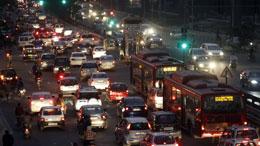Delhi’s odd-even plan lacks vision and will solve absolutely nothing

Photo caption: More buses, less cars. (Reuters/B Mathur)
By Shelly Walia
Special to The Post
With New Delhi’s air pollution off the charts, India’s capital city wants half its cars off the roads.
Under a new rule, the Arvind Kejriwal-led Delhi government has announced that all private cars and two-wheelers will be allowed on the roads only on alternate days. Starting Jan. 1, if vehicles with license numbers ending with odd numbers are out one day, it will be the turn of vehicles with license numbers ending with even numbers the following day, and so on.
Although similar experiments have been attempted in other cities with varying degrees of success, such a move is likely to entirely fail in India’s capital, Pradip Sarkar, head and professor at the Department of Transport Planning at Delhi’s School of Planning and Architecture, told Quartz.
Instead, what the city needs is a robust public transport system, and increase in car parking charges.
Here are the edited excerpts from the interview.
Q: What was your first reaction to the news about the alternate-day travel?
Sarkar: I thought it was a quick fix solution. It has come out without any detailed examination. They (the Delhi government) must have seen similar practices in China, Mexico, and Santiago. But the gravity of the problem—which has a strong bearing on the socio-economic fabric and the population size of the city—has not been taken into consideration.
The government doesn’t have any vision. If you look at Singapore, Hong Kong, and many other small Asian cities, they have done so much (for public transport) that you don’t feel you need a vehicle. Why am I using a vehicle? Because I don’t have an alternative.
The public transport system should be healthy. Delhi needs at least 15,000 more buses. When the CNG (compressed natural gas) buses were implemented, there was a lot of reduction in the pollution levels. I don’t understand why the Delhi government is not doing more in terms of procurement of buses, and instead spending money on flyovers.
Q: Why do you say the Delhi government hasn’t thought this through?
Sarkar: Because the Delhi government has now said it is an experiment. And that, if the experiment is unsuccessful, it will be withdrawn.
Have they made any kind of an experimental design? You engage some scientists and transport specialists, and ask them to develop a simulation model and see what’s the assigned load on the network. They did not do that.
Q: If they do manage to implement this, what could be the repercussions?
Sarkar: The motor vehicle act does not stop you on your mobility. So, there is no legal teeth here. And so, implementation is very difficult. They are not in a position to optimally involve the under-staffed police in this experiment. Delhi has some 30,000 km of roads, and the government does not have the equipment to check or prosecute anybody.
There will be a lot of offenders. It will lead to more corruption in Delhi. Police will take money, and allow the offenders to move on. If you want to challan (fine) them, how much would you? Rs500? There will be people who wouldn’t mind being challaned (penalised), because then they will at least get to use their own cars.
And since they do not have any sort of legality, if somebody is challaned, he or she can go to the court and question it? What’s the authenticity? Has the decision been made in parliament? There’s no support from the central government.
I will also think about buying an old car or maybe a Nano, something that I can afford. And those cars typically emit more pollution.
Q: Apart from building a robust public transport system, what else can the Delhi government do?
Sarkar: Develop pollution and congestion maps to track areas with the highest pollution levels and the highest congestion, and superimpose that information on the GIS (geographical information system) layer. Then try and identify what’s causing congestion and pollution, and take measures accordingly. These measures include placing restrictions on heavy vehicles, diverting cars, introducing traffic management regulations, and then gradually imposing a congestion tax.
In 1975, Singapore implemented the area licensing scheme, under which they charged for entry into certain areas. Once people know that they have to pay, they will be discouraged. If you bring in these kinds of stringent systems one by one, and simultaneously better the public transport, the pollution would improve.
Q: What about congestion caused due to parking?
Sarkar: Yes, even the parking charges should be increased. If you go to Connaught Place and you have to pay Rs500 to park your car, you will think three times.
Q: But how much can the government do alone?
Sarkar: If you see the metro feeder buses, they are very inadequate. The government should have gone into the PPP (public-private partnership) model. Then, the government doesn’t need to buy the buses. It can request private entrepreneurs to operate buses in Delhi, and the regulatory authority could be the government’s. Like, in Indore, there are multiple operators, but the control is with the government.
Shelly is an arts and culture journalist trained at the Columbia Journalism School. Before moving to New York, she spent three years at Business Standard, an Indian financial daily, as a lead Page 1 editor. Her particular areas of interest include Bollywood, gender identity issues, the new wave of Indian start-ups and entrepreneurs, and technology.
This piece was orginally published in Quartz India. See http://qz.com/566846/delhis-odd-even-plan-lacks-vision-and-will-solve-absolutely-nothing/









